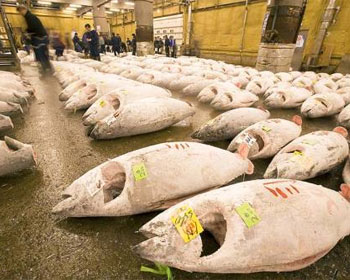|

Southern bluefin tuna for sale in Tokyo, Japan. (Photo: Michel Gunther/WWF-Canon)
CCSBT moves boldly to protect southern bluefin tuna
 (WORLDWIDE, 10/14/2011)
(WORLDWIDE, 10/14/2011)
Delegates to a crucial meeting of the Commission for the Conservation of Southern Bluefin Tuna (CCSBT) recently voted to help the tuna species replenish. They announced the new targets this week for rebuilding stocks of the highly endangered species by 2035.
During the recent meeting in Bali, TRAFFIC, the wildlife trade monitoring network, urged members of the Commission to establish a robust management procedure to allow tuna stocks to return to a biologically safe level as a matter of urgency.
"I think this is the right approach and first step to the approach," stated Joyce Wu, a senior programme officer with TRAFFIC who was present at the meeting.
She praised the delegates’ move and is optimistic about its potential to affect change.
“TRAFFIC is very encouraged that members of CCSBT have agreed on a Management Procedure and set targets for rebuilding the global stock of southern bluefin tuna by 2035. This is the most positive step forward in rebuilding southern bluefin tuna spawning stocks to sustainable levels for at least two decades,” Wu remarked.
“CCSBT is to be congratulated for taking their responsibility seriously and becoming the first of the five tuna regional fisheries management organizations to adopt comprehensive procedures for deciding on the levels of catch for a tuna species,” Wu added.
CCSBT voted to raise the total allowable catch (TAC) for southern bluefin tuna by 1,000 tonnes next year and to increase it by 3,000 tonnes over three years, ABC reports.
The new measures are designed to help to rebuild fish stocks back to sustainable levels and to keep them there in the long term.
The tuna’s spawning stock is now at a historically low level of around 5 per cent because of overfishing. CCSBT’s new measures signify a 70 per cent chance of the stocks reaching 20 per cent of their former levels by 2035.
Australia has the largest quota of the species and its TAC will go up by 12 per cent to 4,528 tonnes in 2012. Still, the rise will not reach pre-2009 catch levels of 5,265 tonnes in three years.
But the Australian tuna fishing industry is celebratory.
"The Australian industry has long argued that the quota should not have been reduced in 2009," said spokesman Brian Jeffriess. "The CCSBT decision to reverse the 2009 cut is recognition that the SBT stock is much stronger than assumed before.”
Meanwhile, other environmental groups had wanted southern bluefin tuna fishing to stop.
"We would like to see the most precautionary management procedure possible," Nathanial Pelle from Greenpeace Australia said. "That would mean that the science around that procedure would be designed to return southern bluefin tuna to what we would call a safe level so it can begin to rebuild its population in a shorter time as possible with the greatest probability of success."
Related article:
- Delegates threaten to disempower CCSBT if it ignores plight of bluefin tuna
By Natalia Real
[email protected]
www.seafood.media
Information of the company:
|
Address:
|
Unit 1, JAA House, 19 Napier Close
|
|
City:
|
Deakin
|
|
Country:
|
Australia
|
|
Phone:
|
+61 2 6282 8396
|
|
Fax:
|
+61 2 6282 8407
|
|
E-Mail:
|
[email protected]
|
More about: 
|
|



